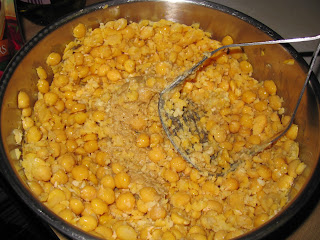Hummus is a Middle Eastern staple food. When eaten with bread it makes a complete protein, which is awesome especially if you're vegetarian or vegan (though understandably less awesome if you suffer from Celiac disease). Hummus is actually pretty easy to make. It relies heavily on taste... so be sure you're tasting as you go. So, here's my recipe, feel free to play with it and adjust as you like.
***
 Hummus, ala the Lazy Wife
Hummus, ala the Lazy Wife1 lb bag dried chickpeas (you can, of course, use canned chickpeas, dried are sometimes cheaper)
Water
1 head of Garlic, minced
The juice of 2 Lemons
1/3 - 1/2 cup Tahini (Sesame seed paste)
1/2 cup Olive Oil
Salt to taste
Optional Hand full of Sun Dried Tomato, Red Pepper, Paprika, Basil, Avocado, Chipotle pepper, etc.

For the Hummus purists (No optional extras):
Soak the dry chickpeas in water overnight. Drain the old water and cover the now plumped peas with water by about an inch over the level of the peas... it's not important to get the water quantity exact for these steps, just to make sure the peas absorb as much water as they need to become soft. Bring the peas to a boil, cover and reduce heat to simmer.
My chickpeas have always boil over... but uncovered they smell funny, so choose your poison.
 |
| Lower: cooked peas, top left: pea skins, top right: naked peas |
Once the chickpeas are soft (30min - 2 hours). It really depends on how much attention I'm paying... when they're soft to the touch (squish one between your fingers after letting it cool and see if it mashes easily) turn off the heat and let them cool.
 | ||
| Hummus with olive oil and paprika |
After removing all the skins, put the peas in a medium to large size bowl. Add the garlic, lemon juice, tahini, olive oil and some salt, and mash until you get a nice smooth paste.
Some of the ingredient amounts can vary depending on how moist or dry your chickpeas are, and how much you like or dislike certain flavors. I happen to LOVE garlic, so I used a whole head... just enough to almost give me heartburn. If you don't like garlic so much, then use 1-5 cloves or whatever you like.
If you find the mashing is not giving you a nice smooth paste, then add a little more tahini, olive oil or lemon juice, depending also on what flavor you think is lacking. You do have to play with it a little, to get the right taste for your pallet.
If you're feeling a little more adventurous, you can experiment a little more.
Make the original recipe, but at the end stir in some chopped up sun dried tomato, or some red pepper, or avocado... I know at the farmer's market I used to go to, there was a guy that had all kinds of interesting flavors of hummus.
In most of the Middle Eastern restaurants I've been to, they serve hummus with olive oil and paprika on it.
If you can't find tahini (which I couldn't for a while where I am) I substituted smooth peanut butter! I know! Sounds totally crazy, right?! Well, I did, but I used a little less peanut butter and a little more olive oil and lemon juice, and lots of garlic. Once it sat for a day in the refrigerator, it tasted pretty much the same as regular hummus, with maybe a little more of a nutty aftertaste.
***
The historical origins of Hummus are unknown. The earliest verified description of hummus comes from 18th century Damascus. There were probably similar recipes before the 18th century, and in fact, the Egyptians ate a similar dish that used vinegar instead of lemon juice (which was the ingredient that arrived in the middle east later than all the others). But it is still unknown where or when hummus, as we know it today, was first made.
Chickpeas are GREAT! Chickpeas are a good source of zinc, folate, and protein. They have a lot of dietary fiber and are a good source of carbohydrates (especially for people that are insulin sensitive/diabetics). They also contain phosphorus, magnesium and iron.
Citations: Wikipedia: Hummus, Chickpea



I love your hummus! I'm sorry that all your hard work will be devoured so quickly!
ReplyDeleteIt's ok... that's what it's there for, really :D
ReplyDelete